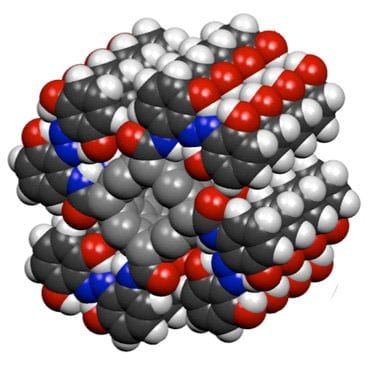
Researchers at the Massachusetts Institute of technology (MIT) have designed a new solar thermal fuel that could store up to 10,000 times more energy than previous systems. The fuel, which has been studied using computational chemistry but not yet fully tested in the lab, consists of carbon nanotubes (CNTs) modified with azobenzene. It is expected to provide the same energy storage per volume as lithium-ion batteries and can store solar energy almost indefinitely. It can also be recharged by simply exposing it to sunlight – no electricity required.
Solar thermal fuels work by storing energy from the Sun in the chemical bonds of molecules. For example, a typical fuel molecule in, say, its ground state A absorbs light from the Sun. This light absorption transforms state A into state B. Here, only the geometry of the molecule changes and no chemical reaction occurs. Such molecules are said to be “photo-switchable”.
The molecule is less stable in state B, because it has a higher energy. The difference between this energy and the energy of the molecules in state A is the amount of energy stored, or ΔH. Even though the molecule is more stable in state A, once it is in state B, it can be made to stay there until a “trigger” provides enough energy for it to overcome the energy barrier between the two states.
Heat on demand
When this trigger – which can be in the form of heat, light or a voltage – is applied, the molecule switches back to state A and the stored energy is released as heat. “We can thus store an amount of energy equal to ΔH per molecule in the solar thermal fuel, and then access the energy as heat when and where desired,” explain team members Alexie Kolpak and Jeffrey Grossman. “For example, the heat can be used directly – to boil water, for instance – or to generate electricity.”
After the heat is released, the solar thermal fuel can easily be recharged by exposing it to sunlight. In principle, the entire cycle could be repeated indefinitely without any loss of performance.
In the hybrid azobenzene/CNT system studied at MIT, the azobenzene is the molecule that stores and releases energy. The CNT acts to bring the azobenzene molecules into close contact with each other so that the molecules interact. “This interaction opens up an entirely new chemical phase space for tuning both the relative energies of states A and B as well as the reaction barrier between them,” explains Kolpak. “By taking advantage of these additional degrees of freedom, a much higher energy-storage capacity and a longer storage lifetime can be designed into the azobenzene system.” He believes that this may also hold true for a number of other well-known chromophores, chemical structures such as azobenzene that absorb light.
High energy density
Although many solar thermal fuels were developed in the 1970s and 1980s, they degraded rather quickly with each cycle. Currently, there is only one solar thermal fuel that can cycle many times without degradation, in addition to the new one created by Kolpak and Grossman, but it is based on ruthenium, which is rare and expensive. What is more, the volumetric energy density of this fuel is very low in contrast to that of azobenzene/CNT, which has a value that is 10,000 greater. “This value is comparable to that of lithium-ion batteries, and high enough for us to realistically envisage our solar thermal fuel in real-world applications,” Kolpak told physicsworld.com. “The fuel also has many other advantages, such as being emission-free and easily rechargeable – you don’t need to be near an electricity source to recharge.”
The team has just started to synthesize and test its compounds and says that it will soon be working with several other groups at MIT to begin developing prototype devices. “We are also continuing to use first-principles calculations to help us design other novel solar thermal fuels,” reveals Kolpak. “We are particularly excited by several systems based on the same concept of combining known photo-switchable molecules with nanoscale templates to enhance their properties.”
The researchers admit that there are still many challenges to overcome before they can even consider commercializing such a technology. On the science side, they need to develop a fundamental understanding of the relationship between the geometry of the hybrid nanostructure-based fuels and their solubility in water and other solvents, and then design and optimize highly soluble structures that still have a high energy density, are thermally stabile and are good at cycling.
“On the experimental side, the first thing we need to do is adapt synthesis methods so that we can attach a large number of photo-switch molecules per CNT, or other ‘template’ molecules, that yield the desired properties,” adds Kolpak. “And finally, we must find ways to integrate solar thermal fuels with existing technologies or design novel and inexpensive new devices.”
The work is reported in Nano Letters.



